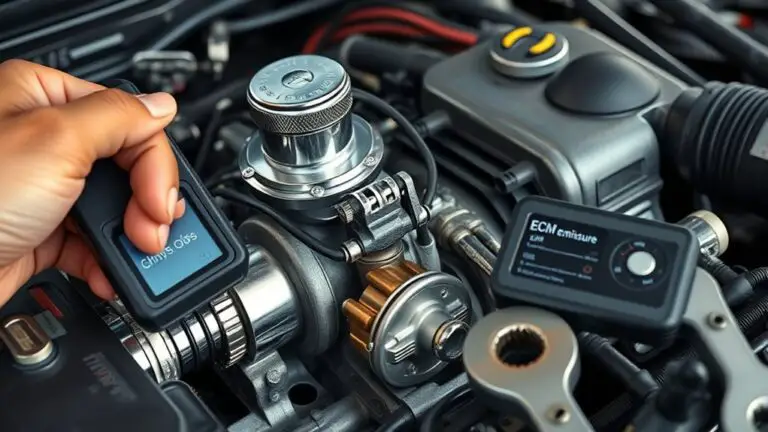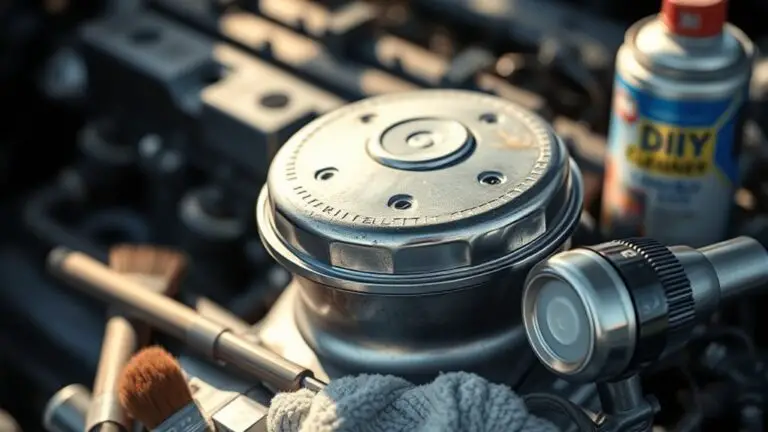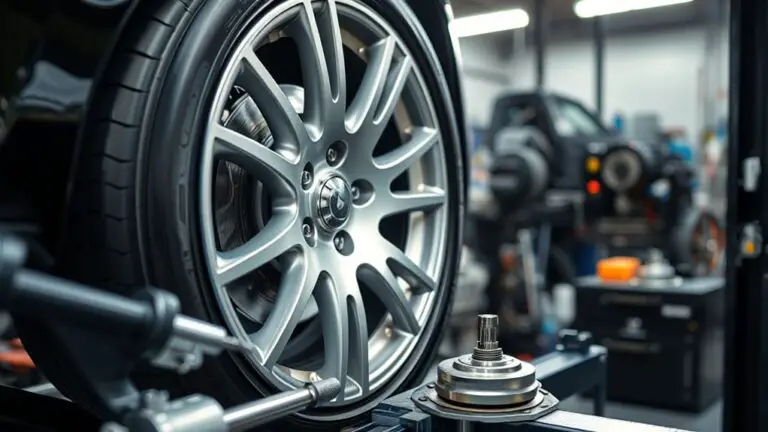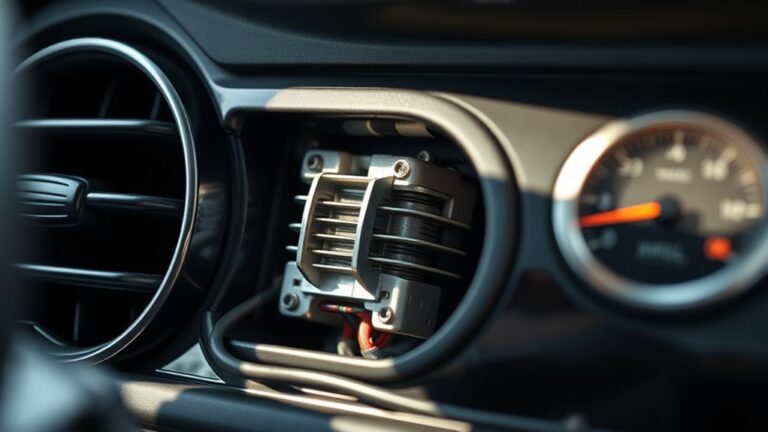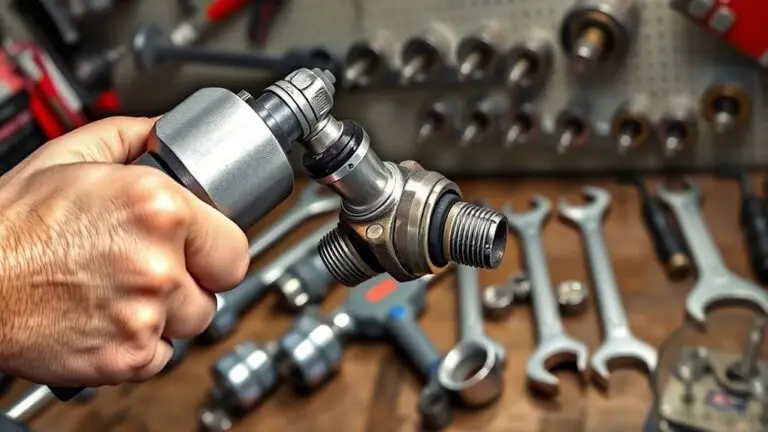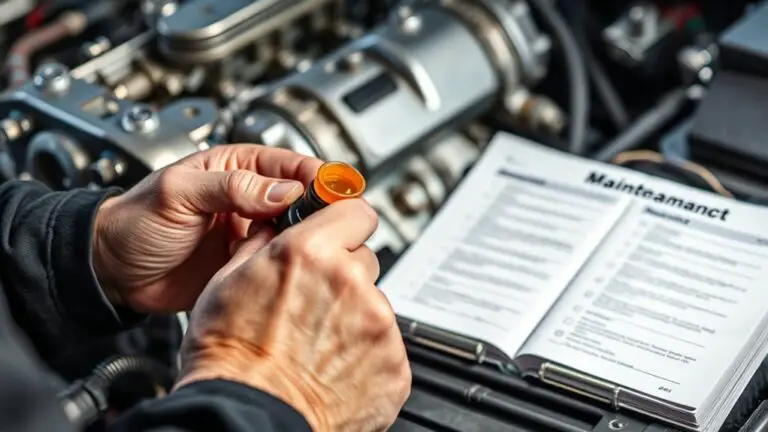Top 10 Causes of Misfire and How to Troubleshoot Them
Misfires often stem from ignition system failures like faulty spark plugs or ignition coils, leading to rough idling. Fuel delivery issues, such as clogged filters or weak pumps, can disrupt performance. Vacuum leaks from cracked hoses or gaskets also contribute. Engine timing problems and blocked air or exhaust systems further exacerbate misfires. Each issue can greatly affect your vehicle’s efficiency. Keep exploring to uncover effective troubleshooting methods for these common causes.
Ignition System Failures

Ignition system failures are one of the leading causes of engine misfire, and they can stem from various components within the system. When your spark timing is off, it can lead to incomplete combustion, resulting in a rough idle or stalling. Proper ignition timing guarantees that the spark plug fires at the ideal moment, igniting the air-fuel mixture efficiently. If you’ve got worn spark plugs, faulty ignition coils, or a malfunctioning distributor, these issues can disrupt your ignition timing and cause significant performance problems.
To troubleshoot, start by checking the spark plugs for wear or carbon buildup. Inspect the ignition coils for any signs of malfunction, as they’re essential for generating the required voltage. Finally, verify that the ignition timing is correctly set according to your vehicle’s specifications. Addressing these ignition system failures can restore the freedom of smooth operation and enhance your driving experience.
Fuel Delivery Problems

Fuel delivery problems can greatly impact engine performance and lead to misfires. If you’ve got a clogged fuel filter, weak fuel pump, or incorrect fuel pressure, your engine may not receive the necessary fuel for ideal combustion. Identifying these issues promptly is essential for maintaining engine efficiency and preventing further complications.
Clogged Fuel Filter
When your vehicle experiences a misfire, one potential culprit could be a clogged fuel filter, which disrupts the necessary fuel delivery to the engine. This blockage can lead to insufficient fuel reaching the combustion chamber, resulting in poor performance and increased emissions. To avoid these issues, consider the following:
- Regular fuel filter maintenance is essential for peak engine function.
- Use high-quality fuel to minimize fuel quality issues that can contribute to filter clogging.
- Replace the filter as recommended by your vehicle’s manufacturer to guarantee consistent fuel flow.
Weak Fuel Pump
A weak fuel pump can considerably impact your vehicle’s performance, leading to misfires and other issues. When the fuel pump begins to fail, it may struggle to deliver adequate fuel pressure, resulting in inconsistent fuel flow to the engine. This can cause your engine to run lean, leading to misfires during acceleration or when under load. To diagnose issues related to fuel pump failure, start by checking the fuel pressure with a gauge; it should align with your manufacturer’s specifications. Listen for unusual sounds from the pump, and inspect for leaks or electrical problems. If you suspect a weak fuel pump, addressing it promptly can restore your vehicle’s efficiency and performance, granting you the freedom to drive confidently.
Incorrect Fuel Pressure
Incorrect fuel pressure can lead to a host of fuel delivery problems that greatly affect engine performance. When the pressure isn’t within the specified range, it can cause issues such as misfires or rough idling. To accurately diagnose this, you’ll need to evaluate your fuel pressure regulators and perform thorough fuel system diagnostics.
- Check for clogged fuel filters that can restrict flow.
- Inspect for leaks in the fuel lines that can cause pressure drops.
- Test the fuel pressure regulator to guarantee it maintains the correct pressure.
Vacuum Leaks
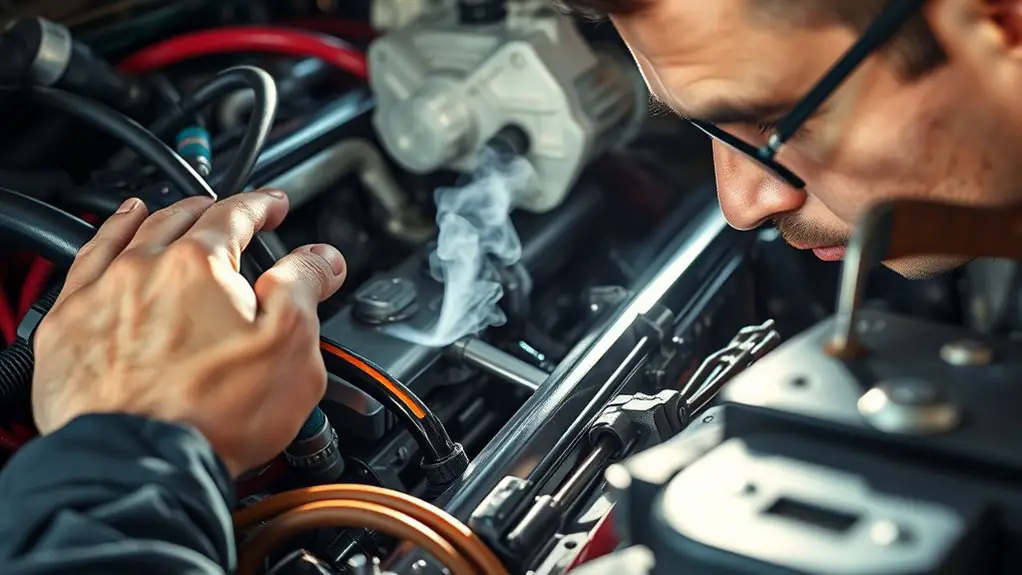
Vacuum leaks can greatly disrupt engine performance, leading to misfires. Common sources include cracked hoses, faulty gaskets, and improperly sealed intake manifolds, which create unmetered air entry. You’ll need to recognize the symptoms, such as rough idling and increased fuel consumption, and employ specific testing methods to identify the exact location of the leak.
Common Leak Sources
When diagnosing engine misfires, identifying common leak sources, such as vacuum leaks, is crucial. Vacuum leaks can disrupt the air-fuel mixture and lead to performance issues. Here are some common leak sources you should be aware of:
- Hoses: Inspect rubber hoses for cracks or wear.
- Intake Manifold: Check the gasket and connections for proper sealing.
- Throttle Body: Verify the throttle body is secured and free from debris.
Utilizing effective leak detection methods, like a smoke test or listening for hissing sounds, can help you pinpoint these issues. By addressing these common leak sources, you’ll enhance your engine’s performance and reliability, giving you the freedom to enjoy a smoothly running vehicle.
Symptoms of Vacuum Leaks
Identifying vacuum leaks is only part of the equation; recognizing the symptoms they produce is equally important for effective diagnosis. You might notice erratic engine performance, such as stalling or rough idling, which are common vacuum leak symptoms. Your engine could also exhibit a high idle speed or difficulty accelerating, as unmetered air disrupts the air-fuel mixture. Additionally, watch for a check engine light, often triggered by a lean condition. If you hear hissing or whistling sounds near the intake, that could indicate a leak. Fuel efficiency may decline, leading to higher operating costs. By staying alert to these symptoms, you can more effectively maintain your engine’s performance and guarantee a smoother driving experience.
Testing for Leaks
To effectively pinpoint vacuum leaks, employing systematic testing methods is essential. One of the most reliable techniques is smoke testing, which involves introducing smoke into the intake system. This method visually identifies leaks, making leak detection straightforward.
Here are three key steps to follow during testing:
- Inspect Visible Components: Check hoses, gaskets, and connections for signs of wear or damage.
- Use a Smoke Machine: Inject smoke while the engine runs; watch for escaping smoke that indicates leaks.
- Monitor Engine Performance: Pay attention to changes in idle speed or engine behavior as you test.
Using these methods will help you efficiently identify and address vacuum leaks, ensuring peak engine performance and preventing misfires.
Faulty Spark Plugs
Although many components contribute to engine performance, faulty spark plugs are often a primary culprit behind misfires. If you’re experiencing rough idling or hesitation during acceleration, it’s time to examine your spark plugs. Proper spark plug maintenance is vital; worn or damaged plugs can lead to incomplete combustion, drastically affecting engine efficiency.
There are various spark plug types—copper, platinum, and iridium—each with unique lifespans and performance characteristics. Copper plugs, while affordable, require more frequent replacements, whereas iridium plugs offer longevity and superior performance.
To troubleshoot, check for signs of wear, such as corrosion or excessive gap widening. Verify you’re using the correct spark plug type for your vehicle, as mismatched plugs can exacerbate issues. Regular inspections and timely replacements will help you maintain peak engine performance and avoid frustrating misfires.
Bad Ignition Coils
When ignition coils fail, you’ll often notice symptoms like rough idling, reduced power, or engine misfires. Testing the functionality of your ignition coils is essential, as a malfunction can disrupt the spark delivery necessary for ideal combustion. Identifying these issues early can prevent further damage to your engine and improve overall performance.
Symptoms of Ignition Coil Failure
Ignition coils play an integral role in the engine’s performance, and failure in these components can lead to a variety of noticeable symptoms. Understanding these symptoms is vital for maintaining your vehicle’s efficiency and reliability.
Here are some common indicators of ignition coil failure:
- Rough Idling: You may notice your engine shaking or vibrating when idling.
- Poor Acceleration: A lack of power when you step on the gas can signal a failing coil.
- Check Engine Light: This warning could indicate issues with various ignition coil types.
Performing coil resistance testing can help diagnose a faulty ignition coil. If you’re experiencing these symptoms, addressing ignition coil issues promptly can prevent further engine damage and guarantee a smoother driving experience.
Testing Ignition Coil Functionality
How can you guarantee your ignition coils are functioning properly? Start with coil resistance testing. Different ignition coil types have varying resistance specifications, so consult your vehicle’s manual for the correct values. Using a multimeter, disconnect the ignition coil and measure the resistance across the terminals. If the readings fall outside the specified range, it’s likely the coil is faulty. Also, check for physical damage, such as cracks or corrosion. If you’re facing misfires, a bad ignition coil might be the culprit. Conducting this simple test can help you identify issues before they escalate, ensuring your engine runs smoothly and efficiently. Stay proactive, and you’ll maintain the freedom of a well-functioning vehicle.
Clogged Fuel Injectors
Although fuel injectors play an essential role in delivering the right amount of fuel to your engine, they can become clogged over time, leading to significant performance issues. A clogged injector can result in poor fuel atomization, misfires, and decreased engine power. To tackle this problem effectively, consider the following steps:
- Fuel Injector Cleaning: Regular cleaning can remove deposits and restore functionality.
- Injector Replacement Options: If cleaning doesn’t resolve the issue, you may need to replace the clogged injectors with new or refurbished ones.
- Fuel Quality Check: Verify you’re using high-quality fuel, as low-grade options can lead to deposits forming in the injectors.
Engine Timing Issues
When engine timing is off, it can lead to misfires that greatly impact performance and efficiency. The timing belt or timing chain guarantees that the engine’s camshaft and crankshaft operate in perfect harmony. If these components wear out or stretch, they can disrupt this synchronization, causing the engine to misfire.
You may also encounter issues with improperly installed timing belts or chains, which can lead to severe timing discrepancies. Regular inspections are essential; look for signs of wear, such as cracks in the timing belt or excessive slack in the timing chain.
If you suspect timing issues, it’s wise to check the engine’s timing marks and adjust them as necessary. Ignoring these problems can result in further engine damage and costly repairs. Remember, maintaining proper engine timing not only enhances performance but also prolongs your vehicle’s lifespan, giving you the freedom to drive confidently.
Air Filter Blockage
A clogged air filter can considerably impact your engine’s performance, leading to misfires and reduced efficiency. When the air filter becomes obstructed, it restricts airflow, causing significant airflow issues. This disruption can create a lean fuel mixture, which often results in incomplete combustion and misfiring.
To troubleshoot air filter blockage, consider these key points:
To effectively address air filter blockage, regularly inspect, clean or replace as needed, and monitor your engine’s performance.
- Inspect Regularly: Check your air filter every 12,000 miles or as recommended by your vehicle’s manufacturer.
- Clean or Replace: If you notice dirt buildup, clean it if it’s reusable or replace it to restore ideal airflow.
- Monitor Performance: Pay attention to any changes in engine performance or fuel efficiency after addressing the air filter.
Exhaust System Restrictions
If your exhaust system is restricted, it can lead to significant engine performance issues, including misfires. One common cause is excessive exhaust backpressure, which can hinder the engine’s ability to expel gases efficiently. This often results from catalytic converter blockage, restricting the flow and causing a buildup of pressure that can disrupt the combustion process.
| Cause | Effect |
|---|---|
| Exhaust Backpressure | Reduced engine efficiency |
| Catalytic Converter Blockage | Increased emissions and heat |
| Muffler Restrictions | Loud engine noise and power loss |
| Damaged Exhaust Pipes | Unusual vibrations and leaks |
| Corroded Components | Rust and further blockage |
To troubleshoot, inspect your exhaust system for any signs of damage or blockage. A thorough cleaning or replacement of affected components may restore proper flow and enhance performance, ensuring your engine runs smoothly and efficiently.
Engine Control Unit (ECU) Malfunctions
Exhaust system restrictions can lead to performance issues, but misfires can also stem from malfunctions in the Engine Control Unit (ECU). The ECU is essential for managing engine functions, and any faults can disrupt the combustion process, resulting in misfires. To troubleshoot ECU-related misfires, you should focus on the following aspects:
- ECU diagnostics: Run thorough diagnostics to identify error codes that highlight specific issues.
- Software updates: Verify your ECU software is current, as outdated software can lead to incorrect fuel maps and ignition timing.
- Wiring and connections: Inspect for damaged wiring or poor connections that can interrupt signals between the ECU and engine components.
Frequently Asked Questions
How Can I Tell if My Fuel Is Contaminated?
You can tell if your fuel’s contaminated by observing certain symptoms. Look for difficulty starting your engine, rough idling, or decreased performance. Fuel testing is essential; you can use a clear container to check for water or debris separation. If you notice unusual smells or colors in the fuel, it’s a sign of contamination. Regularly inspecting your fuel system can help you maintain peak performance and avoid potential damage down the line.
What Tools Do I Need for Troubleshooting Misfires?
You’ll need a few essential tools for troubleshooting misfires. Start with a spark plug socket to inspect and replace spark plugs if necessary. An ignition coil tester is vital for checking coil functionality. A multimeter will help you measure resistance and voltage levels accurately. Don’t forget a code reader to diagnose engine trouble codes. With these tools, you’re well-equipped to explore the mystery of your engine’s performance issues.
Can Weather Conditions Affect Engine Performance?
Yes, weather conditions can definitely affect engine performance. Temperature fluctuations can alter fuel vaporization rates, impacting combustion efficiency. High humidity levels can lead to moisture in the fuel system, causing misfires or rough idling. Additionally, extreme cold can thicken engine oil, making it harder for components to operate smoothly. It’s essential to monitor these conditions, as they can greatly influence how your engine runs and responds during different weather scenarios.
How Often Should I Replace My Air Filter?
You should replace your air filter every 12,000 to 15,000 miles, but if you’re driving in extreme conditions—think driving on dusty roads or in heavy traffic—you might want to do it even sooner. The air filter’s lifespan can drastically affect your engine’s performance, so don’t let it become a neglected hero. Regular filter replacement keeps your engine breathing easy, maximizing efficiency and giving you the freedom to hit the road without worry.
What Are the Signs of an Overheating Engine?
If your engine temperature rises considerably, you’ve likely got overheating symptoms. Look for warning lights on your dashboard, steam escaping from under the hood, or unusual noises like knocking. You might also notice a sweet smell from coolant leaking or a loss of power during acceleration. If you experience these signs, it’s essential to stop the vehicle immediately to prevent severe engine damage. Always keep an eye on your temperature gauge to stay ahead.


